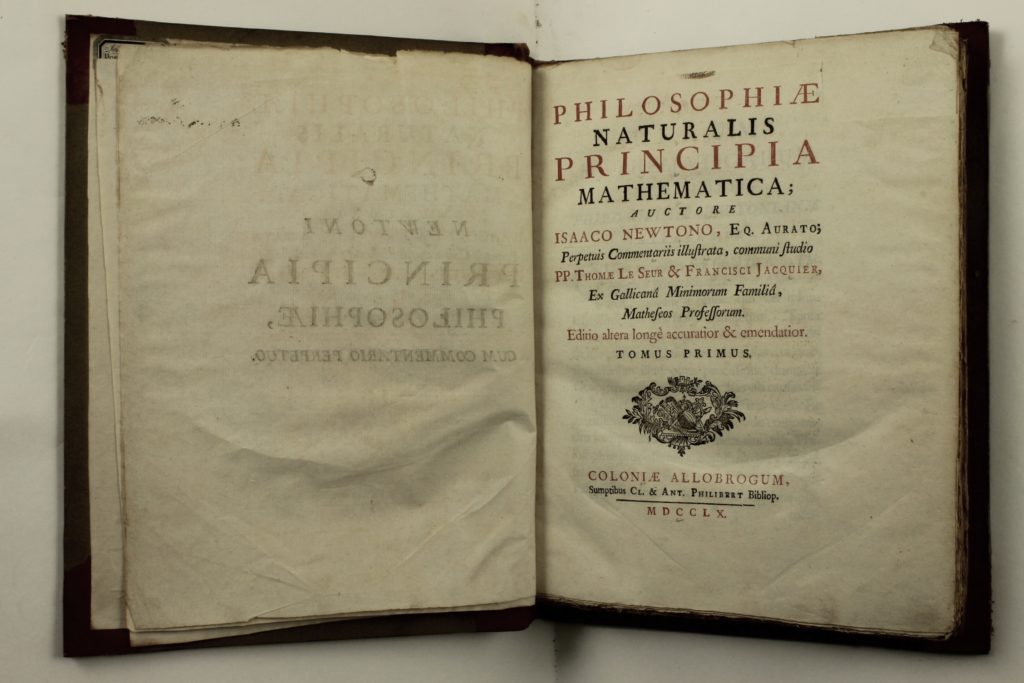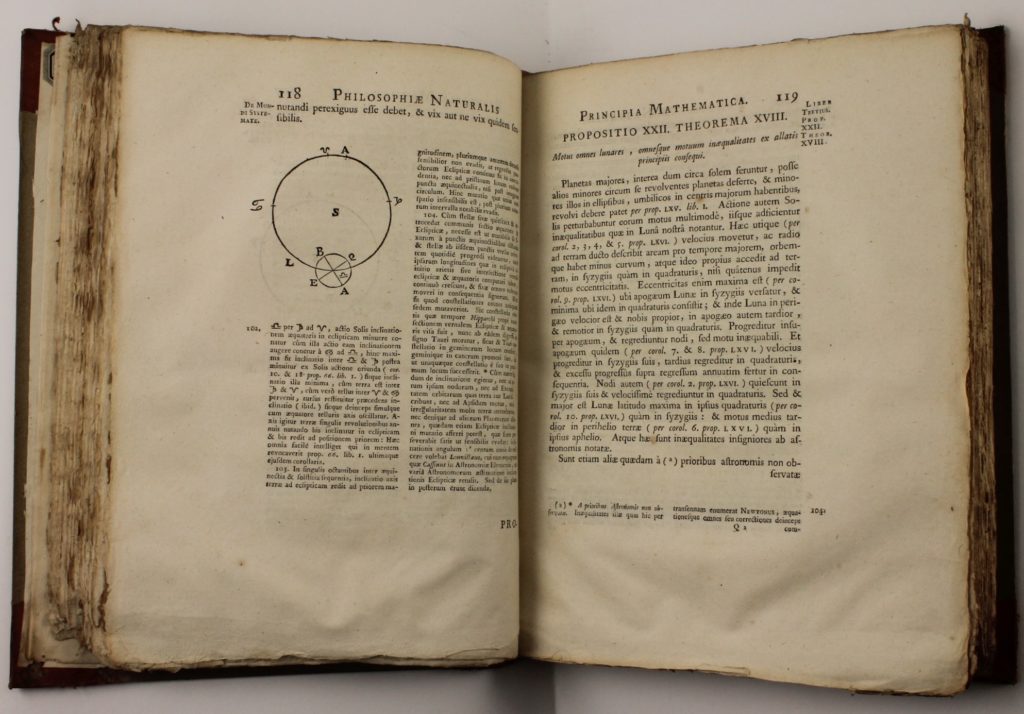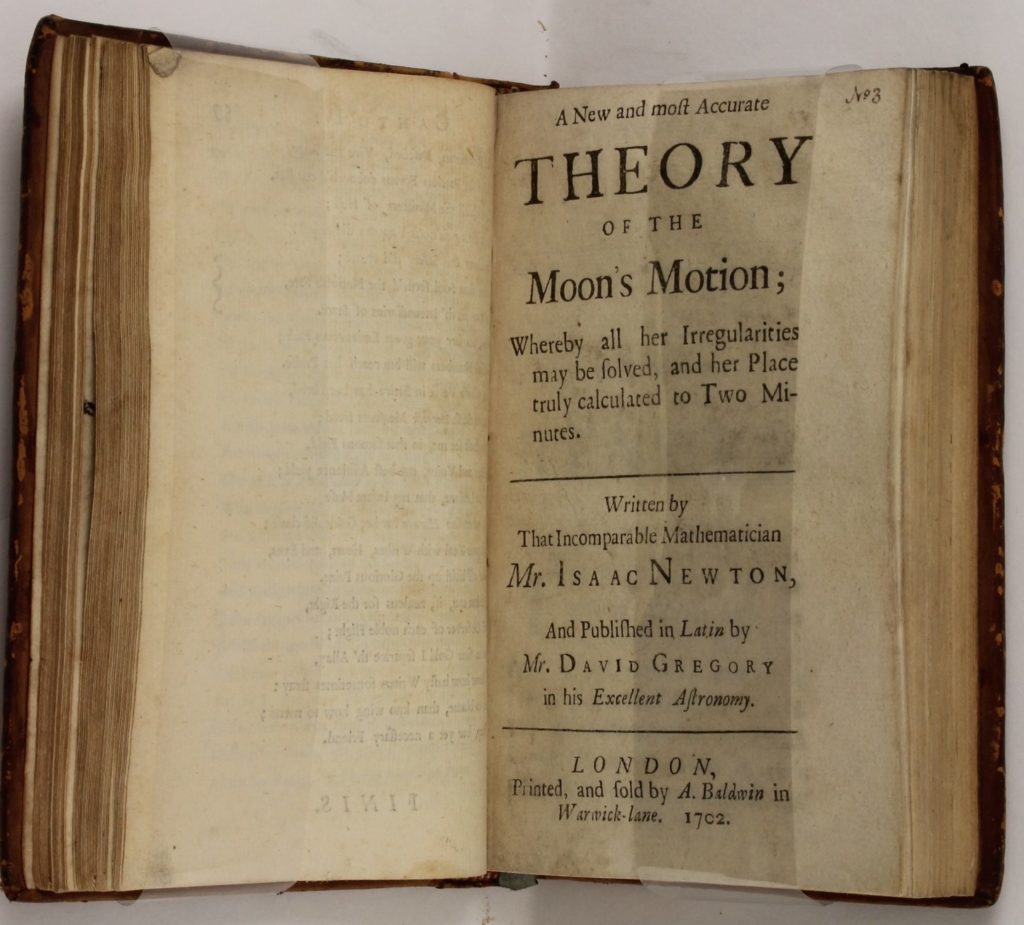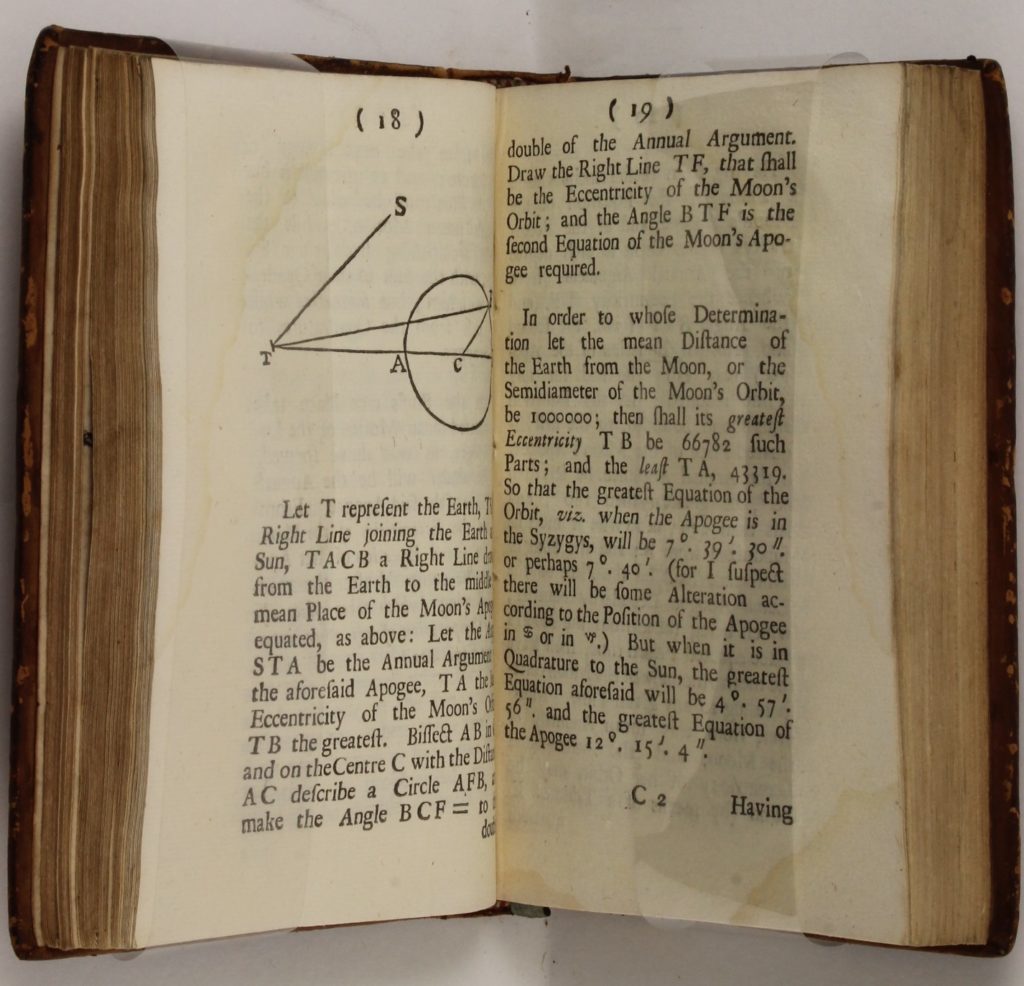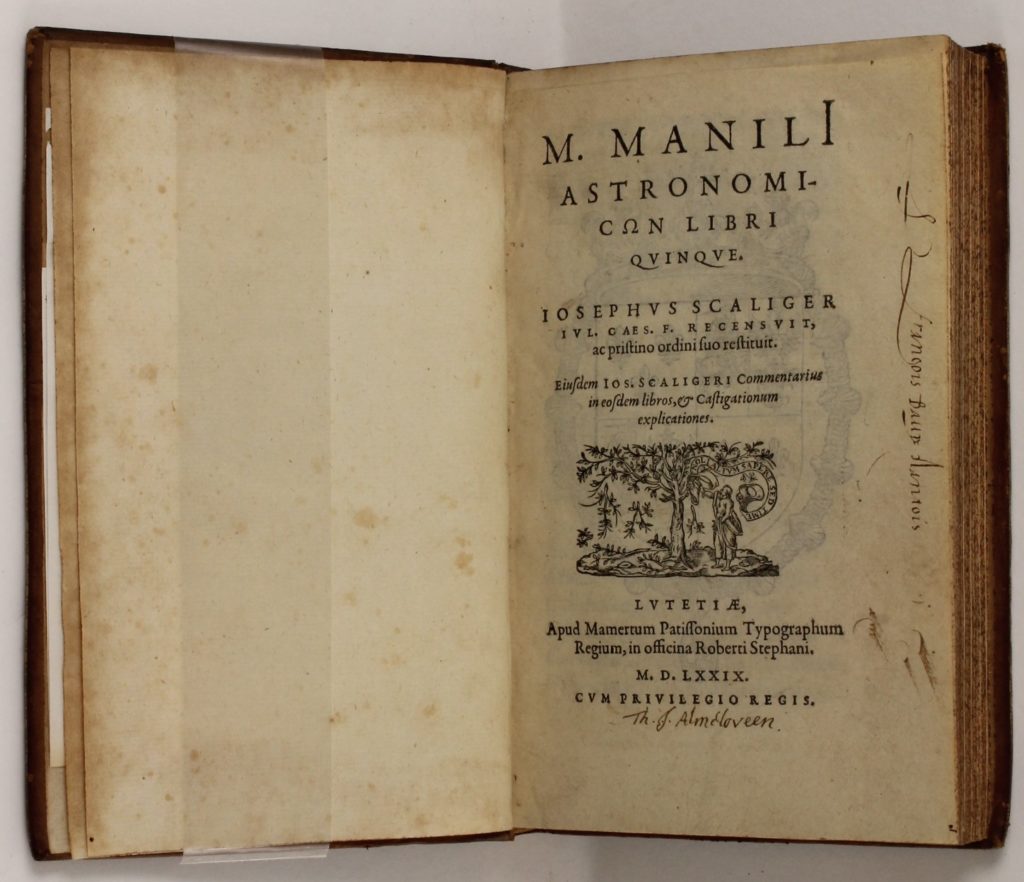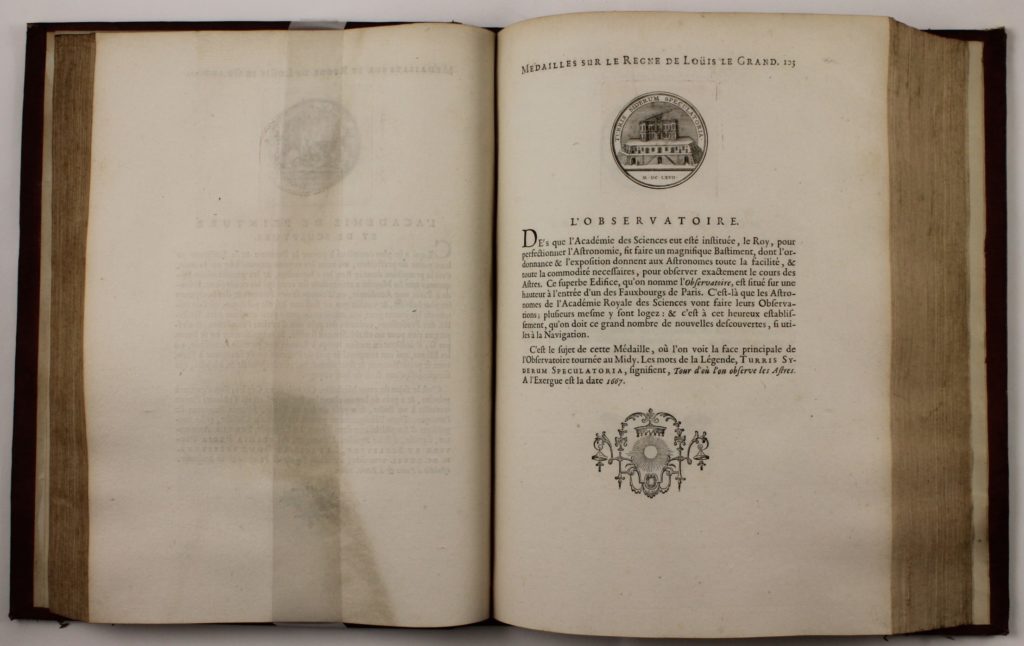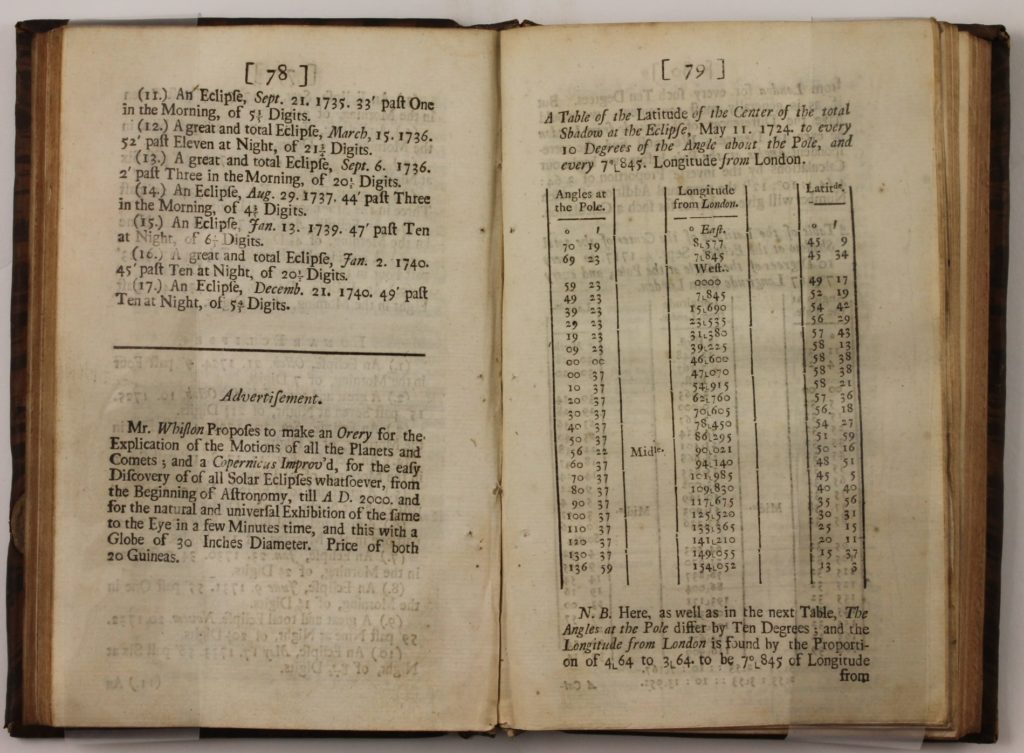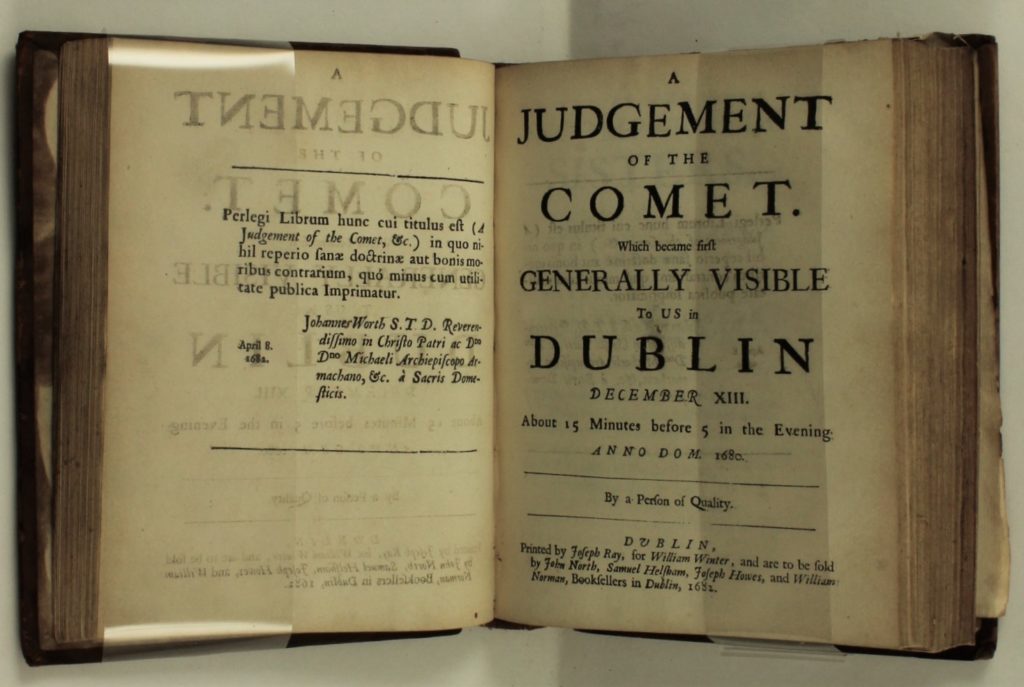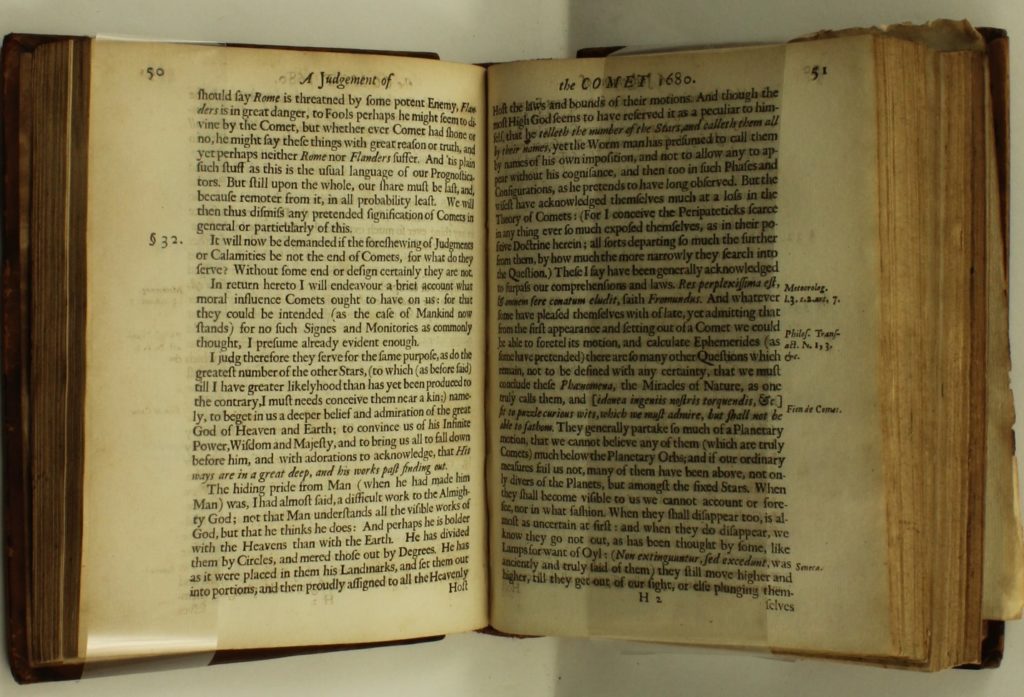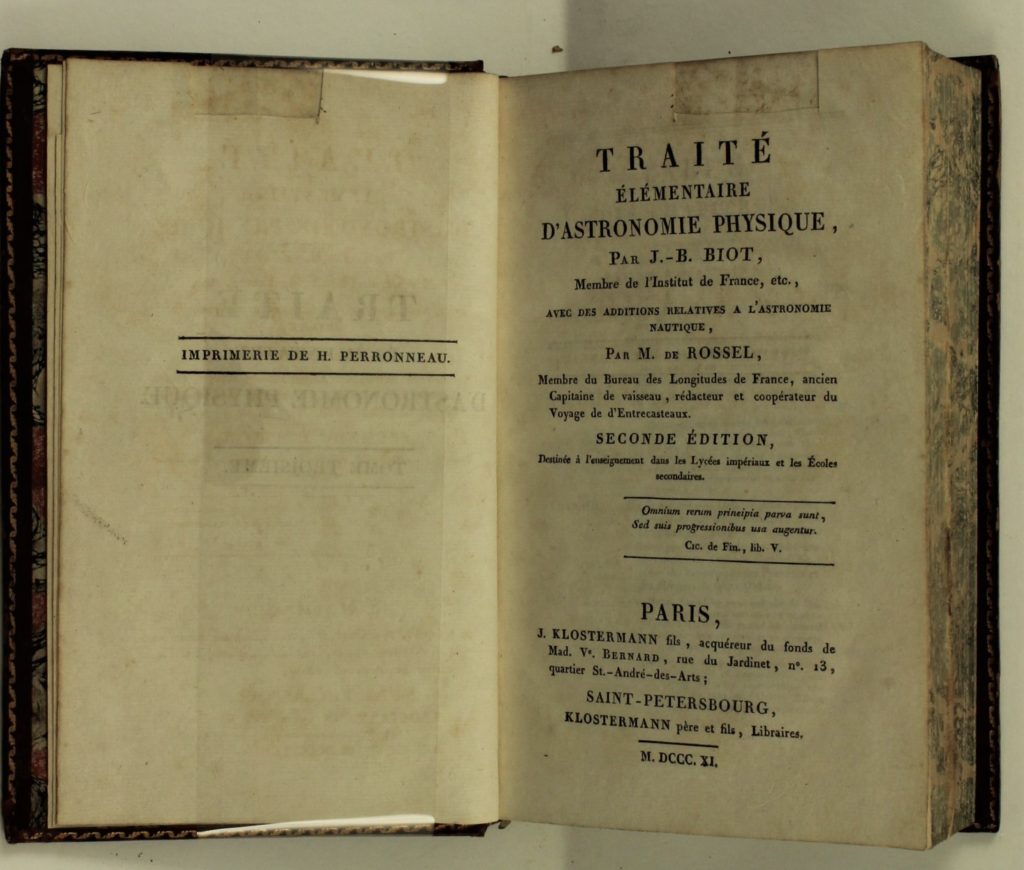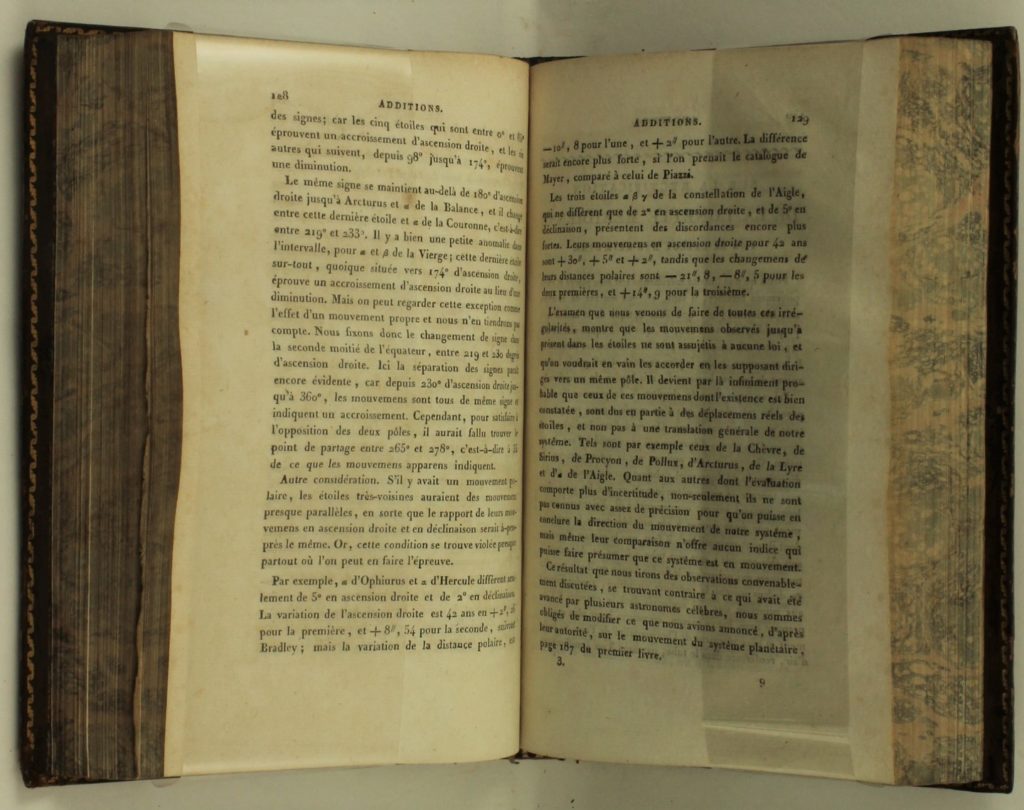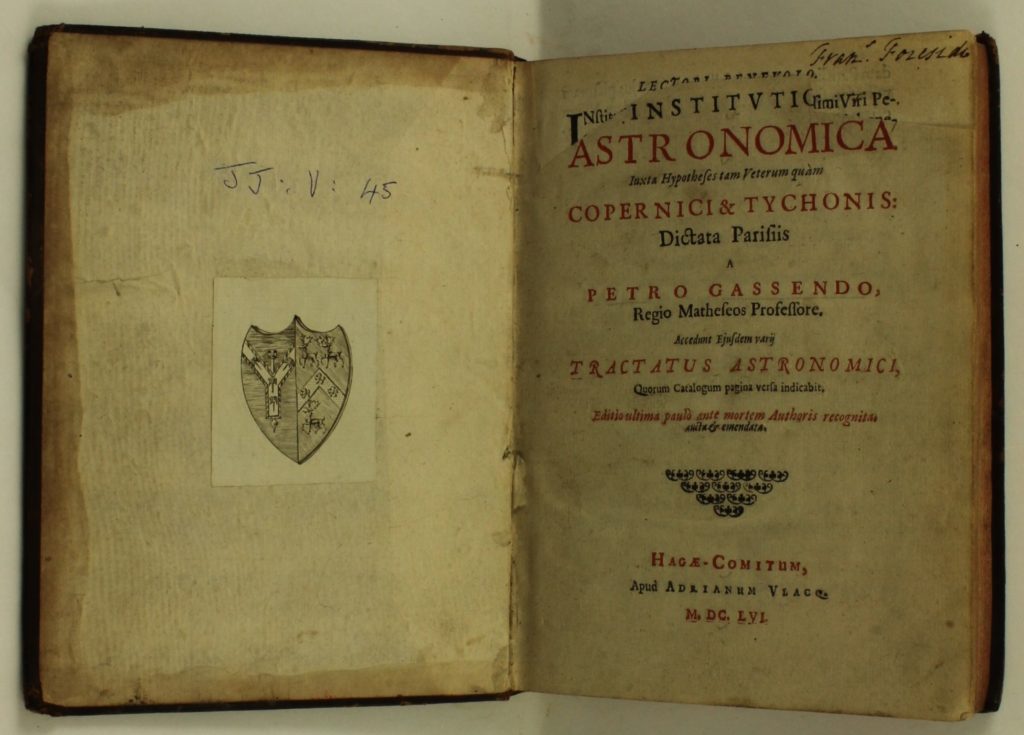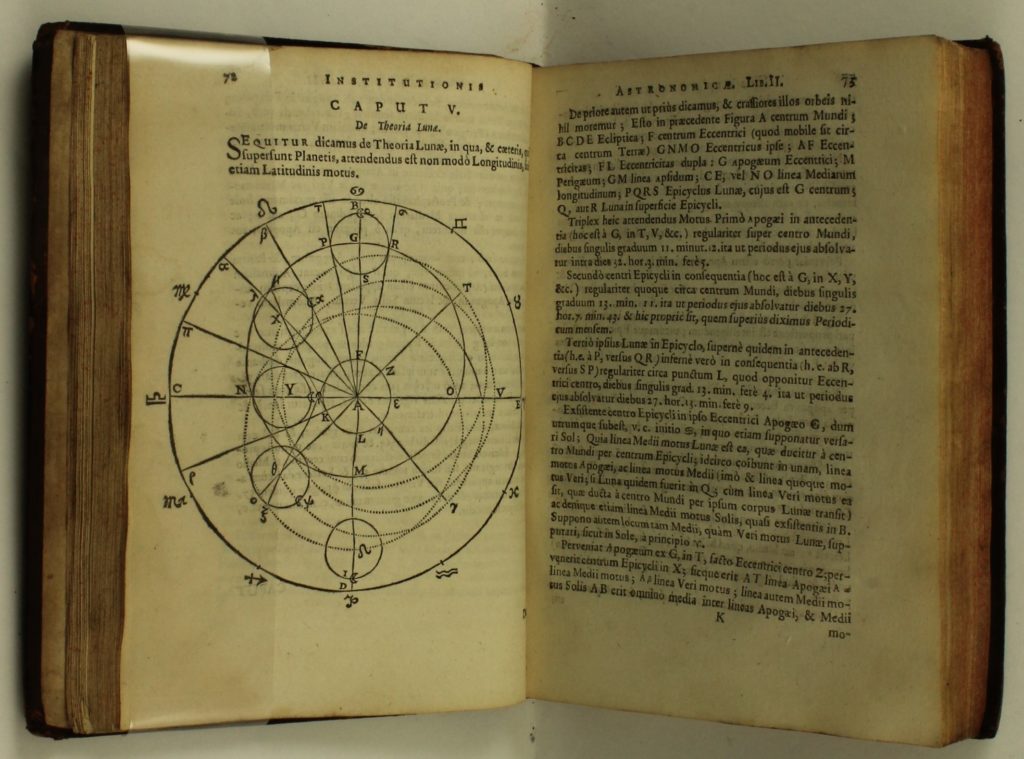
This book exhibition celebrated the 50th anniversary of Armagh Planetarium. It highlights works on astronomy from the collections of the Library.
Astronomy is the branch of science which examines celestial objects, space and the physical universe as a whole. Celestial objects include planets, moons, stars, galaxies and comets.
It is one of the oldest sciences. In Mesopotamia, records of astronomical measurements have been found which date back 5,000 years. Ancient Chinese, Babylonian and Greek civilisations also kept records.
Philosophiae naturalis principia mathematica : auctore Isaaco Newtono, Eq. Aurato ; perpetuis commentariis illustrata, communi studio PP. Thomae Le Seur & Francisci Jacquier, ex Gallicanâ Minimorum Familiâ, Matheseos Professorum. Editio altera longè accuratior & emendatior ... Isaac Newton 1760 P001144118
This work is considered to be one of the most important in the history of science. Newton’s Law of Universal Gravitation is explained in Volume I. Volume III: De Mundi Systemate lists the many consequences of universal gravitation for astronomy.
Newton was an important figure in the Scientific Revolution of the early modern period (1500 – 1800).
At this time, developments in mathematics, physics, astronomy, biology and chemistry transformed the commonly held views of nature.
Copernicus’s heliocentric (sun-centred) astronomical model, published in 1534, is considered the period’s starting point, and Newton’s Philosophiae Naturalis Principia Mathematica its completion.
A New and Most Accurate Theory of the Moon's Motion; Whereby all Her Irregularities May Be Solved, and Her Place Truly Calculated to Two Minutes. Written by that incomparable mathematician Mr. Isaac Newton, and published in Latin by Mr. David Gregory in his excellent Astronomy Isaac Newton 1702 P00166591
In 1694 Isaac Newton visited the King’s Astronomer, Flamsteed, at the Royal Observatory, Greenwich. One of Flamsteed’s main duties was to obtain star positions and to develop a lunar theory (an account of the motions of the Moon) which would be accurate enough for navigators to determine longitudes at sea.
Newton, who saw that Flamsteed’s theory was not accurate enough, tried to develop a more precise theory. The elements of Newton’s A New and Most Accurate Theory of the Moon’s Motion are presented without explanation to support his discovery. Although Newton’s theory is not as accurate as he claimed it to be, it was far more accurate than any other at the time.
M. Manili Astronomicum Libri Quinque. Iosephus Scaliger Iul. Caes. F. Recensuit, ac Pristino Ordini Suo Restituit. Eiusdem Ios. Scaligeri Commentarius In Eosdem Libros, Castigationum Explicationes Marcus Manilius 1579 P001102849
Astrology is the study of the movements and relative positions of celestial bodies (stars, planets and satellites), believing them to have an influence on human society and the natural world.
The Astronomicon, is a poem for instruction about celestial events, the zodiac and astrology. It is the earliest comprehensive work on astrology.
Medailles sur les principaux evenement du regne entier de Louis le Grand, avec des explications historiques [s.n.] 1702 P001387436
Louis XIV founded the Paris Observatory, which was built between 1667 and 1671. He was encouraged to do so by Jean-Baptiste Colbert, Minister of Finances and Secretary of State for the Navy, to increase France’s maritime power and international trade.
The establishment of the Observatory was considered an important achievement and was included in a series of commemorative medals commissioned to celebrate the reign and achievements of Louis XIV.
The calculation of solar eclipses without parallaxes. With a specimen of the same in the total eclipse of the sun, May 11. 1724. Now first made Publick. To which is added, A Proposal how, with the Latitude given, the Geographical Longitude of all the Parts of the Earth may be settled by the bare Knowledge of the Duration of Solar Eclipses, and especially of Total Darkness. With An Account of some late Observations made with Dipping Needles, in order to discover the Longitude and Latitude at Sea. By Will. Whiston, M. A. Sometime Professor of the Mathematicks in the University of Cambridge. William Whiston 1724 P001553514
In 1724, the mathematician and theologian, William Whiston, published a broadsheet, The Calculation of Solar Eclipses Without Parallexes, on the occasion of the solar eclipse of that year.
The solar eclipses of 1724 and 1737 offered him many opportunities to make a living from lecturing, writing, teaching, and selling glasses and instruments.
A Judgement of the Comet Which Became First Visible to Us In Dublin December XIII. about 15 minutes before 5 in the Evening anno Dom. 1680. By a Person of Quality Edward Wettenhall 1682 P00118960x
Between late 1680 and early 1681, a very large and bright comet was seen in the sky throughout much of the Northern Hemisphere. Discovered by German astronomer, Gottfried Kirch, it was the first comet to be observed through a telescope. It was apparently so bright that it was visible even during daytime! Aptly called the Great Comet of 1680, it was also known as Kirch’s comet.
Many thought the comet was a sign of impending divine punishment. In his text Edward Wettenhall, Bishop of Cork and Ross, and a member of the Dublin Philosophical Society, tried to reassure readers that the comet was nothing supernatural and that its presence was to
‘beget in us a deeper belief and admiration of the great God of Heaven and Earth’
Traité Élémentaire D'astronomie Physique, par J.-B. Biot, Membre de l'Istitut de France, etc., avec des Additions Relatives à L'astronomie Nautique, par m. de Rossel ... Seconde Édition, destinée à L'enseignement dans le Lycées Impériaux et les Écoles Secondaires J.B. Biot 1811 P001144886
In the early 1800s, the French physicist and astronomer Jean-Baptiste Biot, was concerned that the results of modern scientific research were not being integrated into the education system quickly enough. In 1805, he published this textbook Traité Élémentaire d’Astronomie Physique, specifically for teaching in secondary schools.
Biot was very important in establishing the extraterrestrial origin of meteors. In April 1803, a shower of more than 3,000 ‘stones’ landed near the town of L’Aigle in France.
Biot was sent by the Académie Française to investigate them. He found evidence to support the extraterrestrial origin of the stones.
Firstly, the type of stone that had fallen was completely different to anything found locally. Secondly, a large number of witnesses from all walks of life saw ‘a rain of stones thrown by the meteor’.
Since Biot’s discovery, the analysis of meteorites has resulted in accurate measurements of the chemical composition of the solar system.
Institutio astronomica iuxta hypotheses tam veterum quam Copernici et Tychonis ... accedunt ejusdem varii tractatus astronomici. Pierre Gassendi 1656 P001407046
This textbook on astronomy is in three books. The first book teaches elements of the spheres, the second the models of the planets, and the third book discusses the systems of Copernicus and of the Danish astronomer, Tycho Brahe.
The French astronomer and mathematician, Pierre Gassendi, was a renowned scientist and the first person to observe the transit of a planet, namely Mercury, across the sun, as predicted by Kepler.

